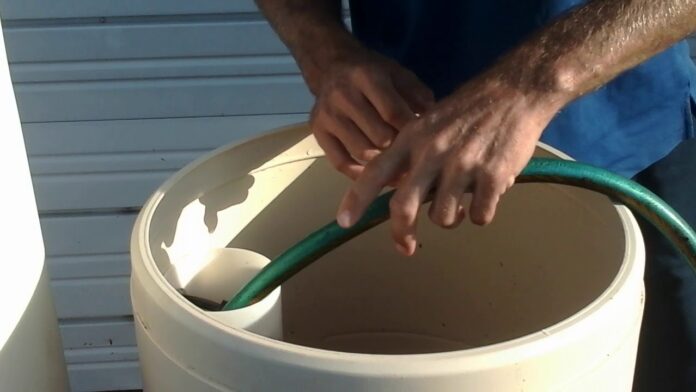Hard water can be damaging not only to your drinking water but also to your water-using appliances and plumbing fixtures. To effectively deal with hard water in your home, you’ll need to install a water softener. A water softener works by removing calcium and magnesium minerals from hard water.
But just like most important home devices, the water softener will require proper, regular maintenance. Maintaining your water softener will help prolong its lifespan, ensure that it operates efficiently, and prevent costly repairs.
Here is a step-by-step guide on how to maintain your water softener:
Check the salt level
One of the most important maintenance tasks for a water softener is to regularly check and replenish the salt level. Salt is an essential part of the water softening process as it regenerates the resin beads that remove calcium and magnesium from the water.
Without enough salt, the water softener will be less effective at softening hard water. To check the salt level, simply lift up the lid of the brine tank and take a look inside. If the salt level is low, add more until it reaches the fill line. If you’re using block salt, it may be best to have a technician raise your water level to submerge the block completely.
Clean the brine tank
Another important maintenance task for a water softener is to clean the brine tank on a regular basis. Over time, the brine tank can become clogged with sediment, which can reduce its efficiency.

To clean the brine tank, simply add a few gallons of water to the tank, then stir up the salt with a broom handle. This will help loosen any sediment that has built up. Once you’ve stirred up the salt, drain out the water and dispose of it properly. Repeat this process a few times until the water runs clear.
Use Appropriate Type of Salt
It’s important to use the right type of salt in your water softener. The most common type of salt used is sodium chloride, but you can also use potassium chloride. If you have a high-efficiency water softener, you may need to use a different type of salt.
Other important grades of salt you may consider include rock salt, solar salt, and evaporated salt pellets. For the best results, evaporated salt pellets are considered the best because it’s the purest out there. Check with your manufacturer to see what type of salt is best for your model.
Clean a Water Softener Resin Tank
Cleaning a water softener resin tank is important to do every few years. The resin beads can become fouled with minerals and organic matter, which reduces their effectiveness. You’ll know it’s time to clean the tank when your water doesn’t feel as soft as it used to.

While the regeneration process will remove buildup from these beads, this becomes less effective as the beads reach the seven-year mark. To clean the resin tank, you’ll need to remove all the salt and then flush the tank with a high-pressure hose. Be sure to follow the manufacturer’s instructions for cleaning the tank.
However, the best way to clean your water softener resin tank is to have a professional replace the resin beads. This is usually done every ten years or so to ensure optimal performance.
Break up Salt Bridges
If you find that your water softener isn’t working as well as it used to, there’s a chance that a salt bridge has formed. This happens when the salt forms a hard crust on top of the water in the brine tank. To break up a salt bridge, simply use a broom handle or other long object to break up the crust.
Once the crust is broken, the salt will be able to dissolve back into the water, and your water softener will be able to work properly again. You can also soften the bridge and make it easy to break by pouring hot water over it. If you have repeated problems with bridging and mushing, then use less salt and let the salt drop lower between refills. Make sure you know how to add salt to your water softener to avoid salt bridges.
Dissolve Salt Mushing at the Bottom of the Tank
If the salt has formed a hard layer at the bottom of the tank, it can be difficult to get it to dissolve again. You can dissolve the salt by pouring hot water into the tank and then running the water softener through a regeneration cycle. The hot water will help break up the salt so that it can dissolve again. If you have a lot of salt mushing, you may need to add more salt to the tank to get it to dissolve.
Clean the Venturi Valve
During the regeneration cycle, the nozzle and venturi valve creates the suction that transports the brine solution into the resin tank. If you have hard water, the minerals can build up in the venturi valve and cause it to become clogged. The venturi valve is what allows the salt water to mix with the fresh water to create the brine that cleans your dishes and clothing.
You can clean the venturi valve by taking it apart and soaking it in vinegar for a few hours. You can do this by unscrewing the cover, removing the internal parts, and cleaning them with soap and water. In most cases, you’ll need to clean your valve twice a year to keep it clear of debris. Failing to relieve water pressure before disassembling the valves could damage parts or cause injury.
Use a Water Softener Cleaner
In addition to vinegar, you can also use a water softener cleaner to clean your resin bead. These cleaners are designed to remove mineral deposits and build-up from the valve and other parts of your water softening system.

To maximize the lifespan of your resin beads, pour water softener cleaner into the brine tank during a routine maintenance inspection. Let the system run a manual regeneration cycle to flush out the cleaner along with the impurities.
You can find water softener cleaners at most hardware stores or online. Follow the directions on the cleaner’s label to ensure you’re using it correctly.
Replace the Filter
If your water softener has a filter, it will need to be replaced periodically. The frequency with which you need to replace the filter will depend on the type of filter and the quality of your water.
Consult your owner’s manual or the manufacturer to determine how often to replace your water filter. If you have sediment in your water, you may need to replace the filter more frequently. Consider a whole house water filter as they are considered the best.
Address the Problems as Soon as They Happen
With the proper settings, your system will be able to provide a steady, sufficient flow of softened water. Most water softeners have four basic settings, which mainly revolve around the regeneration cycle.
To set your water softener properly, you’ll need to make sure that the frequency, timing, and duration of the regeneration cycle are all set correctly. These settings will be specific to your home and family’s water usage, so it’s important that you consult your owner’s manual or the manufacturer for more information.
If you notice that your water softener isn’t working properly, it’s important to take care of the problem as soon as possible. A delay in addressing the issue can lead to bigger problems down the road, so it’s best to nip it in the bud as soon as you notice something amiss.
Empty the Brine Tank
One of the most important maintenance tasks for your water softener is to regularly empty the brine tank. This tank is where salt and water are mixed together to create a brine solution that’s used to wash away the hard water minerals from your home’s water supply.
Over time, the brine solution can become saturated with these minerals, making it less effective at softening your water. This can lead to a build-up of hard water minerals in your home’s plumbing, which can cause all sorts of problems.
To prevent this from happening, you should empty the brine tank every few months and refill it with fresh salt and water. You may also need to occasionally clean the tank with a mild bleach solution to remove any build-up of minerals. Make sure you shut off water intake by using the bypass valve.
Remove the Brine Grid from the Base of the Tank
Some water softener models have a mesh platform at the base of the brine tank. Set this aside before cleaning the tank. This will help you avoid damaging it during the cleaning process.
Scrub with Soapy Water
Fill the tank with a solution of warm water and dish soap. Use a soft brush to scrub away any dirt, grime, or salt build-up. After that, dump out the soapy water and rinse with plain water.
Exercise the Valves
Once a month, adjust the bypass valve to temporarily cut off the softener from your water supply. Twist the intake and outtake valves to the off position and then back to their original position. This will backwash any accumulated dirt and grime from the resin beads.
After a few minutes, return the valve to the “filter” position. This will keep the valves in a good working condition. If the valve leaks or drips, disassemble it and replace any damaged washers or seals.
FAQs on How to Maintain Your Water Softener
How to service a water softener?
- To service a water softener, you will need to do the following:
- Clean the brine tank
- Clean the resin bed
- Exercise the valves
- Replace any damaged washers or seals
How to maintain a water softener system?
- To maintain your water softener system, you need to do the following:
- Check the salt level in the brine tank and add salt as needed.
- Clean the resin bed every few months.
- Deal with the problems as soon as they happen
- Replace your worn out water softener parts, for example, if you have a faulty shower head, consider replacing it with the best water softener shower head on the market.
Final Thought on How to Maintain Your Water Softener
Maintaining a water softener is an essential part of owning one. By properly caring for your system, you can extend its lifespan and ensure that it continues to work properly. In addition to the tips above, be sure to read the manufacturer’s instructions carefully and follow their recommendations. Doing so will help you keep your water softener in top shape for years to come.
The post How to Maintain Water Softener appeared first on Kitchen Infinity.
kitcheninfinity.com










